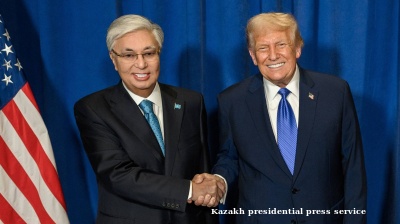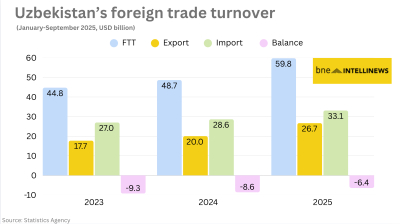Fintech is growing fast in Central Asia as banking sectors looking to leapfrog the traditional financial sector development go straight to high-tech solutions for local people’s lending and spending needs.
Uzbekistan’s Oasis has set its sights on providing credits to the significantly underserved small and medium-sized enterprise (SME) sector in Uzbekistan that is the backbone of the economy and on making available widely needed small credits needed to keep the sector running.
SMEs plays a vital role in the country's economy, contributing to 60% of its GDP and employing 78% of its 35mn population. In a young country with one of the youngest populations in the Former Soviet Union (FSU), the government is also looking to SMEs to provide the millions of jobs its citizens need. Worldwide, countries need to generate over 600mn jobs by 2030 to accommodate population growth that is largely centred in the emerging markets.
The Uzbekistan government has established an ambitious economic agenda to attain upper-middle-income country status by 2030, which is closely tied to supporting local businesses and driving economic activity. Its “Digital Uzbekistan 2030” programme is intended to play a key role in this development.
SMEs account for seven out of ten formal jobs in emerging and frontier markets (EM/FM). However, nearly 40% of SMEs in these economies face a lack of financing, resulting in an annual financing gap of $5.2 trillion, the emerging and frontier market specialist fund Sturgeon Capital said in a recent report.
According to the Findex report in 2021, out of the 30% of Uzbekistan's adults who borrowed in the last year, 22% sought funds from informal sources such as family and friends. Oasis intends to make the need for small loans to SMEs its business model.
“The country’s banking sector’s assets account for 40-45% of the GDP, with a credit-to-GDP ratio of roughly 20-25%, most of which is being lent to state-owned or state-backed enterprises. The SMEs have 12-15% of the credit-to-GDP ratio, while the consumers have around 5-8%,” Sturgeon Capital reports, which is a shareholder in the company. “Compared to economies of similar size and development, private capital is scarce for consumers and businesses.”
During their initial visit to Uzbekistan in Q4 2019, the Oasis team, led by international investors Philip Pott and Scott Richards and also backed by the Finnish development fund Finnfund, discovered limited players in the microfinancing sector. “The largest player had around $10mn in total assets, offering loans fully collateralised on automobiles with a loan-to-value ratio (LVR) of 75-80% and interest rates in the low 60% range,” Sturgeon Capital reports. “Given that there was approximately $2-2.5bn in lending capacity to SMEs in the country, the founders recognised a significant opportunity. Business owners were queuing outside existing microfinance institutions (MFIs), seeking financing options despite high-interest rates and collateral requirements.”
With a lack of interest in lending to SMEs by the dominant domestic banks, these SMEs often rely on supplier or buyer credit to fund their working capital or friends and family.
“Since most SMEs lack sufficient funds for cash on delivery (COD) payments, they end up relying on credit lines provided by suppliers, resulting in implied interest rates as high as 110-120% APR. This level is comparable to rates seen in other emerging markets like Peru or Bolivia several decades ago,” says Sturgeon Capital.
Oasis aims to bridge this financing gap by offering lending solutions tailored to the needs of Uzbekistan's SMEs. The team recognises the immense potential to provide affordable and accessible credit to business owners who have previously faced limited options. By doing so, Oasis strives to empower SMEs, drive economic growth and contribute to the country's goal of becoming an upper-middle-income nation by 2030.
When comparing Oasis to traditional banks, the key differentiating factor lies in their approval and disbursement timeframes. Banks typically take three to four weeks to process loan applications due to extensive documentation and collateral requirements. However, SME entrepreneurs have limited flexibility when it comes to working capital and are more concerned with timely access to credit rather than interest rates.
To address this need, Oasis offers lower interest rates compared to their microfinance institutions (MFI) competitors, charging 60% interest. While this is higher than the 20% offered by banks, Oasis provides uncollateralised lending. The goal for 2023 is to achieve an impressive time-to-yes of one hour and a time-to-money of two hours, further enhancing their competitive advantage.
Currently, Oasis loan officers visit SMEs in the field to collect specific cashflow-related data, such as liquidity and debt service coverage ratios. This information is then sent to the underwriting department to make decisions on microloans. As more data on SMEs becomes available, including repayment behaviour and business-related metrics like revenues per square metre and cash in the till, Oasis plans to build robust underwriting algorithms to automate loan processing, credit line expansion and onboarding of new SMEs.
The long-term vision for Oasis includes an open API architecture and a software-as-a-service (SaaS) model. This approach will facilitate seamless integration with other financial systems and enable the company to scale efficiently.
Looking ahead, as more SMEs gain loan approvals and contribute to the country's economic growth, the Oasis team hopes to see policy changes in the tax regime. The current paper-based process and simplified tax compliance scheme limit the potential for SMEs to expand. Digitising tax data and updating it in real time, while simultaneously lowering tax rates to accommodate a broader user base, would increase tax revenues and enable private companies to offer a wider range of financial products. This would promote financial inclusion for SMEs and contribute to the government's 2030 agenda of growing the middle class and boosting economic development.
Tech

Russia blocking messaging apps again, sets up copycat Telegram app
Russia’s internet watchdog Roskomnadzor has been blamed for another round of internet outages in Russia, as the state sets up a Telegram messaging app clone as the Kremlin continues to take increasing control of RuNet.

Albania’s AI minister ‘pregnant’ with 83 children, PM says
AI “minister” Diella will give birth to dozens of digital parliamentary assistants for ruling party MPs.

Is Kazakhstan building a digital utopia, or a China-style surveillance state?
Many Kazakhs will tell you that officials should limit their ambitions to fixing the internet speed. Others worry that the time for joking is over.

Kia inaugurates $310mn "highly automated" automotive plant in Kazakhstan
Featuring 68 industrial robots, the plant is designed to produce up to 70,000 vehicles annually.




